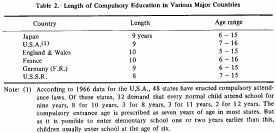| Home > Policy > White Paper, Notice, Announcement > White Paper > EDUCATIONAL STANDARDS IN JAPAN 1971 > CHAPTER |
||
Compulsory education in Japan begins at the age of six and its length is nine years. The lengths of compulsory education in other major countries are as shown in Table 2.

Note: (l) According to 1966 data for the U.S.A., 48 states have enacted compulsory attendance laws. Of these states, 32 demand that every normal child attend school for nine years. 8 for 10 years, 3 for 8 years, 3 for 11 years, 2 for 12 years. The compulsory entrance age is prescribed as seven years of age in most states. But as it is possible to enter elementary school one or two years earlier than this, children usually enter school at the age of six.
In France, as of 1960 the length of compulsory education was extended from eight to tan Years. In the Federal Republic of Germany, beginning around 1965,those states in which the number of years of compulsory schooling had been eight years extended it by one year and now it is nine years in all states. In the U.S.A., the majority of states enforce compulsory education for nine years, but in some states, the length is as long as 12 years.
Today, the extension of compulsory school years has become a controversial issue in many countries of the world. This problem can be approached in two ways. One is to start compulsory education earlier. The other is to extend it upward. The recent extensions of compulsory education in France and Germany are examples of the latter approach. In England and Wales, the number of compulsory school years is to be extended from ten to eleven years beginning in 1972, and in the U.S.S.R. efforts are being made to implement plans for the complete enforcement of ten year compulsory education by 1970.
As for the extension of compulsory education downward, the tendency has been to take measures guaranteeing universal entrance rather than making it compulsory for pre-school children to attend school. For example, in the U.S.A. the Educational Policies Commission of the National Education Association proposed in 1966 those opportunities for free public education should be given to four year olds and up in order to provide all children at the pre-school level with early childhood education. In the Federal Republic of Germany, experiments to lower the entrance age from six to five years of age are being conducted in several states and the Federal Government has given the highest priority to pre-school education. In addition to England and Waies where compulsory education begins at the age of five, it is to be noted that in the U.S.A. and France the proportion of five year olds enrolled in institutions of pre-school education has shown a marked increase in recent years, substantially reaching the stage of universal attendance.
| Back to Top | MEXT HOME |